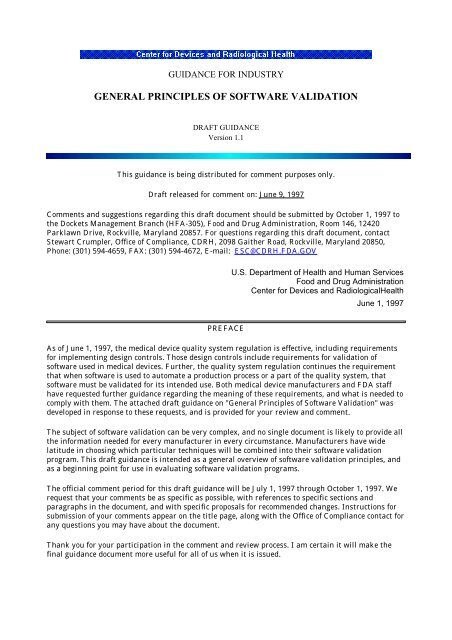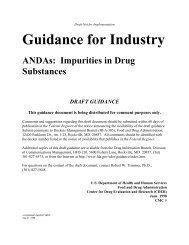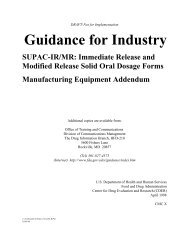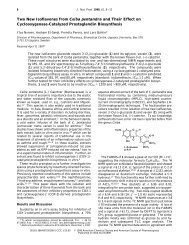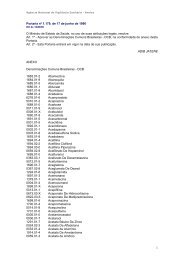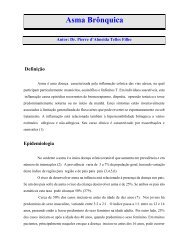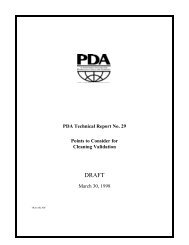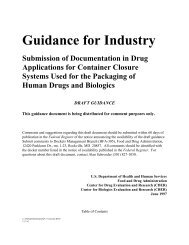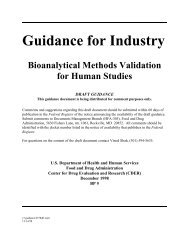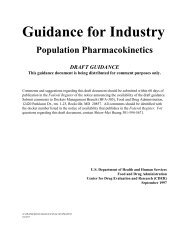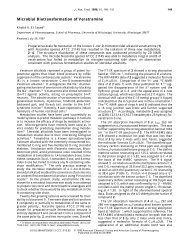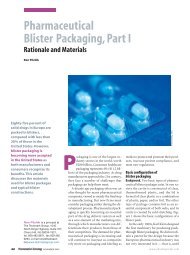GENERAL PRINCIPLES OF SOFTWARE VALIDATION - Pharmanet
GENERAL PRINCIPLES OF SOFTWARE VALIDATION - Pharmanet
GENERAL PRINCIPLES OF SOFTWARE VALIDATION - Pharmanet
You also want an ePaper? Increase the reach of your titles
YUMPU automatically turns print PDFs into web optimized ePapers that Google loves.
GUIDANCE FOR INDUSTRY<br />
<strong>GENERAL</strong> <strong>PRINCIPLES</strong> <strong>OF</strong> S<strong>OF</strong>TWARE <strong>VALIDATION</strong><br />
DRAFT GUIDANCE<br />
Version 1.1<br />
This guidance is being distributed for comment purposes only.<br />
Draft released for comment on: June 9, 1997<br />
Comments and suggestions regarding this draft document should be submitted by October 1, 1997 to<br />
the Dockets Management Branch (HFA-305), Food and Drug Administration, Room 146, 12420<br />
Parklawn Drive, Rockville, Maryland 20857. For questions regarding this draft document, contact<br />
Stewart Crumpler, Office of Compliance, CDRH, 2098 Gaither Road, Rockville, Maryland 20850,<br />
Phone: (301) 594-4659, FAX: (301) 594-4672, E-mail: ESC@CDRH.FDA.GOV<br />
U.S. Department of Health and Human Services<br />
Food and Drug Administration<br />
Center for Devices and RadiologicalHealth<br />
June 1, 1997<br />
PREFACE<br />
As of June 1, 1997, the medical device quality system regulation is effective, including requirements<br />
for implementing design controls. Those design controls include requirements for validation of<br />
software used in medical devices. Further, the quality system regulation continues the requirement<br />
that when software is used to automate a production process or a part of the quality system, that<br />
software must be validated for its intended use. Both medical device manufacturers and FDA staff<br />
have requested further guidance regarding the meaning of these requirements, and what is needed to<br />
comply with them. The attached draft guidance on "General Principles of Software Validation" was<br />
developed in response to these requests, and is provided for your review and comment.<br />
The subject of software validation can be very complex, and no single document is likely to provide all<br />
the information needed for every manufacturer in every circumstance. Manufacturers have wide<br />
latitude in choosing which particular techniques will be combined into their software validation<br />
program. This draft guidance is intended as a general overview of software validation principles, and<br />
as a beginning point for use in evaluating software validation programs.<br />
The official comment period for this draft guidance will be July 1, 1997 through October 1, 1997. We<br />
request that your comments be as specific as possible, with references to specific sections and<br />
paragraphs in the document, and with specific proposals for recommended changes. Instructions for<br />
submission of your comments appear on the title page, along with the Office of Compliance contact for<br />
any questions you may have about the document.<br />
Thank you for your participation in the comment and review process. I am certain it will make the<br />
final guidance document more useful for all of us when it is issued.
Validação de Software<br />
Lillian J. Gill<br />
Director<br />
Office of Compliance<br />
Center for Devices and Radiological Health<br />
I. PURPOSE<br />
II. SCOPE<br />
Table of Contents<br />
A. Applicability<br />
B. Audience<br />
C. Quality System Regulations for Software Validation<br />
D. Quality System Regulation vs Pre-Market Submissions<br />
III. DISCUSSION<br />
A. Software is Different<br />
B. Benefits of Software Validation<br />
C. Definitions and Terminology<br />
IV. <strong>PRINCIPLES</strong> <strong>OF</strong> S<strong>OF</strong>TWARE <strong>VALIDATION</strong><br />
A. Timing<br />
B. Management<br />
C. Plans<br />
D. Procedures<br />
E. Requirements<br />
F. Testing<br />
G. Partial Validation<br />
H. Amount of Effort<br />
I. Independence<br />
J. Real World<br />
V. S<strong>OF</strong>TWARE <strong>VALIDATION</strong><br />
A. Initial Validation Considerations<br />
B. Software Life Cycle Activities<br />
C. Design Reviews<br />
D. Typical Validation Tasks<br />
1. Management<br />
2. Requirements<br />
3. Design<br />
4. Implementation (Coding)<br />
5. Integration and Test<br />
VI. INSTALLATION TESTING<br />
VII. MAINTENANCE AND S<strong>OF</strong>TWARE CHANGES<br />
BIBLIOGRAPHY<br />
DEVELOPMENT TEAM
Validação de Software<br />
I. PURPOSE<br />
This draft guidance outlines general validation principles that the Food and Drug Administration<br />
(FDA) considers to be applicable to the validation of medical device software or the validation of<br />
software used to design, develop or manufacture medical devices.<br />
II. SCOPE<br />
A. Applicability<br />
This draft guidance is applicable to all medical device software, including blood establishment<br />
software, and to software used to design, develop or manufacture medical devices. This draft guidance<br />
document represents the agency's current thinking on validation of software related to medical<br />
devices. It does not create or confer any rights for or on any person and does not operate to bind FDA<br />
or the public. An alternative approach may be used if such approach satisfies the requirements of the<br />
applicable statute, regulations or both.<br />
This document discusses how the general provisions of the Quality System Regulation apply to<br />
software and the agency's current approach to evaluating a software validation system. For example,<br />
this document lists validation elements which are acceptable to the FDA for the validation of<br />
software; however, it does not list all of the activities and tasks that must, in all instances, be used to<br />
comply with the law.<br />
This document does not recommend any specific life cycle model or any specific validation technique<br />
or method, but does recommend that software validation activities be conducted throughout the entire<br />
software life cycle. For each software project, the responsible party should determine and justify the<br />
level of validation effort to be applied, and the specific combination of validation techniques to be<br />
used.<br />
This document is based on generally recognized software validation principles and could therefore be<br />
applicable to any software. For FDA purposes, this draft guidance is applicable to any software<br />
related to a regulated medical device as defined by Section 201(h) of the Federal Food, Drug, and<br />
Cosmetic Act (Act) and by current FDA software and regulatory policy. It is not the intent of this<br />
document to determine or identify specifically which software is or is not regulated.<br />
B. Audience<br />
The FDA intends this draft guidance to provide useful information and recommendations to the<br />
following individuals:<br />
• Persons subject to the Medical Device Quality System Regulation<br />
• Persons responsible for the design, development or production of medical device software<br />
• Persons responsible for the design, development, production or procurement of automated tools<br />
used for the design, development or manufacture of medical devices, or software tools used to<br />
implement the quality system itself<br />
• FDA Scientific Reviewers<br />
• FDA Investigators<br />
• FDA Compliance Officers<br />
C. Quality System Regulations for Software Validation<br />
Software validation is a requirement of the Quality System Regulation, 21 CFR Part 820, which was<br />
published in the Federal Register (61 FR 52602) on October 7, 1996, and takes effect on June 1, 1997.<br />
Validation requirements apply to software used in medical devices, to software that is itself a medical<br />
device (e.g., software used in blood establishments), as well as to software used in production of the
Validação de Software<br />
device or in implementation of the device manufacturer's quality system.<br />
Unless specifically exempted in a classification regulation, all medical device software developed after<br />
June 1, 1997, regardless of its device class, is subject to applicable design control provisions of 21 CFR<br />
820.30. This includes completion of current development projects, all new development projects, and<br />
all changes made to existing medical device software. Specific requirements for validation of device<br />
software are found in 21 CFR 820.30(g). In addition, formal design reviews and software verification<br />
are integral parts of an overall software validation, as required by 21 CFR 820.30(e) and (f).<br />
Any software used to automate any part of the device production process or any part of the quality<br />
system must be validated for its intended use, as required by 21 CFR 820.70(i). This requirement<br />
applies to any software used to automate device design, testing, component acceptance,<br />
manufacturing, labeling, packaging, distribution, complaint handling, or to automate any other aspect<br />
of the quality system. Such software may be developed in-house or under contract, but it is most likely<br />
to be purchased off-the-shelf for a particular intended use. This off-the-shelf software may have many<br />
capabilities, only a few of which are needed by the device manufacturer. The software must be<br />
validated for those specific uses for which it is intended. All production and/or quality system software<br />
must have documented requirements which fully define its intended use, and against which testing<br />
results and other verification evidence can be compared, to show that the production and/or quality<br />
system software is validated for its intended use.<br />
D. Quality System Regulation vs Pre-Market Submissions<br />
This document addresses Quality System Regulation issues; specifically, the implementation of<br />
software validation. It provides guidance for the management and control of the software validation<br />
process. Although software validation is required for automated processes, requirements for process<br />
validation are not addressed in this document.<br />
Manufacturers may use the same procedures and records for compliance with quality system and<br />
design control requirements, as well as for pre-market submissions to FDA. It is not the intent of this<br />
document to cover any specific safety or efficacy issues related to software validation. Design issues<br />
and documentation requirements for pre-market submissions of regulated software are not addressed<br />
by this document. Specific design issues related to safety and efficacy, and the documentation<br />
required in pre-market submissions, are addressed by the Office of Device Evaluation (ODE), Center<br />
for Devices and Radiological Health (CDRH) or by the Office of Blood Research and Review, Center<br />
for Biologics Evaluation and Research (CBER). See the bibliography for reference to applicable<br />
guidance documents for premarket submissions.<br />
Back to Table of Contents<br />
III. DISCUSSION<br />
Many people have asked for specific guidance on what FDA expects them to do to assure compliance<br />
with the Quality System Regulation with regard to software validation. Information on software<br />
validation presented in this document is not new. Validation of software using the principles and<br />
tasks listed in Sections IV and V has been conducted industry-wide for well over 20 years.<br />
FDA recognizes that, because of the great variety of medical devices, processes, and manufacturing<br />
facilities, it is not possible to state in one document all of the specific validation elements that are<br />
applicable. Several broad concepts, however, have general applicability which persons can use<br />
successfully as a guide to software validation. These broad concepts provide an acceptable framework<br />
for building a comprehensive approach to software validation. Additional specific information is<br />
available from many of the references listed in the bibliography.<br />
A. Software is Different from Hardware<br />
While software shares many of the same engineering tasks as hardware, it is different. The quality of<br />
a hardware product is highly dependent on design, development and manufacture, whereas the<br />
quality of a software product is highly dependent on design and development with a minimum
Validação de Software<br />
concern for software manufacture. Software manufacturing consists of reproduction which can be<br />
easily verified. For software, the hardest part is not manufacturing thousands of programs that work<br />
alike; it is getting just one program that works to design specifications. The vast majority of software<br />
problems are traceable to errors made during the design and development process.<br />
Unlike hardware, software components are rarely standardized. While object oriented development<br />
holds promise for reuse of software, it requires a significant up front investment of resources to define<br />
and develop reusable software code. Many of the available object oriented development tools and<br />
techniques have not yet been adopted for medical device applications.<br />
One of the most significant features of software is branching -- its ability to execute alternative series<br />
of commands, based on differing inputs. This feature is a major contributing factor for another<br />
characteristic of software -- its complexity. Even short programs can be very complex and difficult to<br />
fully understand.<br />
Typically, testing alone cannot fully verify that software is complete and correct. In addition to<br />
testing, other verification techniques and a structured and documented development process should<br />
be combined to assure a comprehensive validation approach.<br />
Unlike hardware, software is not a physical entity and does not wear out. In fact, software may<br />
improve with age, as latent defects are discovered and removed. Again, unlike hardware failures,<br />
software failures occur without advanced warning. The software's branching, which allows it to follow<br />
differing paths during execution, can result in additional latent defects being discovered long after a<br />
software product has been introduced into the marketplace.<br />
Another related characteristic of software is the speed and ease with which it can be changed. This<br />
factor can lead both software and non-software professionals to the false impression that software<br />
problems can be easily corrected. Combined with a lack of understanding of software, it can lead<br />
engineering managers to believe that tightly controlled engineering is not as much needed for<br />
software as for hardware. In fact, the opposite is true. Because of its complexity, the development<br />
process for software should be even more tightly controlled than for hardware, in order to prevent<br />
problems which cannot be easily detected later in the development process.<br />
Repairs made to correct software defects, in fact, establish a new design. Seemingly insignificant<br />
changes in software code can create unexpected and very significant problems elsewhere in the<br />
software program.<br />
B. Benefits of Software Validation<br />
Software validation is a critical tool in assuring product quality for device software and for software<br />
automated operations. Software validation can increase the usability and reliability of the device,<br />
resulting in decreased failure rates, fewer recalls and corrective actions, less risk to patients and<br />
users, and reduced liability to manufacturers. Software validation can also reduce long term costs by<br />
making it easier and less costly to reliably modify software and revalidate software changes. Software<br />
maintenance represents as much as 50% of the total cost of software. An established comprehensive<br />
software validation process helps to reduce the long term software cost by reducing the cost of each<br />
subsequent software validation.<br />
C. Definitions and Terminology<br />
Some commonly used terminology in the software industry can be confusing when compared to<br />
definitions of validation and verification found in the medical device Quality System Regulation. For<br />
example, many software engineering journal articles and textbooks use the terms "verification" and<br />
"validation" interchangeably, or in some cases refer to software "verification, validation and testing<br />
(VV&T)" as if it is a single concept, with no distinction among the three terms. For purposes of this<br />
guidance and for compliance with the Quality System Regulation, FDA considers "testing" to be one of<br />
several "verification" techniques, and considers "validation" to be the umbrella term that encompasses<br />
both verification and testing. Unless otherwise specified herein, all other terms are as defined in the<br />
current edition of the FDA "Glossary of Computerized System and Software Development
Validação de Software<br />
Terminology."<br />
Verification is defined in 21 CFR 820.3(aa) as "confirmation by examination and provision of objective<br />
evidence that specified requirements have been fulfilled." In a software development environment,<br />
software verification is confirmation that the output of a particular phase of development meets all of<br />
the input requirements for that phase. Software testing is one of several verification activities,<br />
intended to confirm that software development output meets its input requirements. Other<br />
verification activities include walkthroughs, various static and dynamic analyses, code and document<br />
inspections, both informal and formal (design) reviews and other techniques.<br />
For purposes of this guidance, a working definition of software validation is "establishing by objective<br />
evidence that all software requirements have been implemented correctly and completely and are<br />
traceable to system requirements" [Ref: NIST 500-234]. Software validation is essentially a design<br />
verification function as defined in 21 CFR 820.3(aa) and 820.30(f), and includes all of the verification<br />
and testing activities conducted throughout the software life cycle. Design validation encompasses<br />
software validation, but goes further to check for proper operation of the software in its intended use<br />
environment. For example, both alpha and beta testing of device software in a simulated or real use<br />
environment, and acceptance testing of an automated testing tool by a device manufacturer, may be<br />
included as components of an overall design validation program for a software automated device.<br />
The Quality System Regulation [21 CFR 820.3(k)] defines "establish" to mean "define, document and<br />
implement." Where it appears in this guidance, the word "establish" should be interpreted to have<br />
this same meaning.<br />
Back to Table of Contents<br />
IV. <strong>PRINCIPLES</strong> <strong>OF</strong> S<strong>OF</strong>TWARE <strong>VALIDATION</strong><br />
This section lists the general validation principles that FDA considers to be applicable to both the<br />
validation of medical device software and the validation of software used to design, develop or<br />
manufacture medical devices.<br />
A. Timing<br />
Proper software validation is not a one time event. Software validation should begin when design<br />
planning and design input begin. The software validation process should continue for the entire<br />
software life cycle. The software validation effort may pause with the release of each new version, but<br />
the software validation process does not end until the software product is no longer used.<br />
B. Management<br />
Software cannot be properly validated without an established software life cycle. Proper validation of<br />
software includes the planning, execution, analysis, and documentation of appropriate validation<br />
activities and tasks (including testing or other verification) throughout the entire software life cycle.<br />
C. Plans<br />
Established design and development plans should include a specific plan for how the software<br />
validation process will be controlled and executed.<br />
D. Procedures<br />
Validation tasks should be conducted in accordance with established procedures.<br />
E. Requirements<br />
To validate software, there must be predetermined and documented software requirements<br />
specifications [Ref: 21 CFR 820.3(z) and (aa) and 820.30(f) and (g)].
Validação de Software<br />
F. Testing<br />
Software verification includes both static (paper review) and dynamic techniques. Dynamic analysis<br />
(i.e., testing) is concerned with demonstrating the software's run-time behavior in response to selected<br />
inputs and conditions. Due to the complexity of software, dynamic analysis alone may be insufficient<br />
to show that the software is correct, fully functional and free of avoidable defects. Therefore, static<br />
approaches and methods are used to offset this crucial limitation of dynamic analysis. Dynamic<br />
analysis is a necessary part of software verification, but static evaluation techniques such as<br />
inspections, analyses, walkthroughs, design reviews, etc., may be more effective in finding, correcting<br />
and preventing problems at an earlier stage of the development process. These static techniques can<br />
and should be used to focus or augment dynamic analysis.<br />
Software test plans, test procedures and test cases should be developed as early in the software life<br />
cycle as possible. Such discipline helps to assure testability of requirements specifications and design<br />
specifications, and provides useful feedback regarding those specifications at a time when changes can<br />
be implemented most easily and cost effectively.<br />
G. Partial Validation<br />
Software cannot be partially validated. When a change is made to a software system (even a small<br />
change), the validation status of the entire software system should be addressed, and not just the<br />
validation of the individual change. Retrospective validation and reverse engineering of existing<br />
software is very difficult, but may be necessary in order to properly document and validate changes<br />
made to previously unvalidated software.<br />
H. Amount of Effort<br />
The magnitude of the software validation effort should be commensurate with the risk associated<br />
with the device, the device's dependence on software for potentially hazardous or critical functions,<br />
and the role of specific software modules in higher risk device functions. For example, while all<br />
software modules should be validated, those modules which are safety critical should be subject to<br />
more thorough and detailed inspections of software requirements specifications, software design<br />
specifications and test cases.<br />
Likewise, size and complexity of the software project is an important factor in establishing the<br />
appropriate level of effort and associated documentation for the software. The larger the project and<br />
staff involved, the greater the need for formal communication, more extensive written procedures and<br />
management control of the process. However, small firm size is not a proper justification for<br />
inadequately staffing, controlling, or documenting the development and validation effort for a<br />
complex software project.<br />
I. Independence<br />
Validation activities should be conducted using the basic quality assurance precept of "independence<br />
of review." Self-validation is extremely difficult; an independent review is always better. Smaller<br />
firms may need to be creative in how tasks are organized and assigned, or may need to contract for<br />
some validation activities, in order to establish independence of review.<br />
J. Real World<br />
It is fully recognized that software is designed, developed, validated and regulated in a real world<br />
environment. It is understood that environments and risks cover a wide spectrum, so that each time a<br />
software validation principle is used, the implementation may be different.<br />
Environments can include the application of software for the control of manufacturing, medical<br />
devices, design and development systems as well as quality systems. In each environment, software<br />
components from many sources may be used to create the application (e.g., in-house developed<br />
software, off-the-shelf software, contract software, shareware). In addition, software components come
Validação de Software<br />
in many different forms (e.g., application software, operating systems, compilers, debuggers,<br />
configuration management tools and many more).<br />
The use of software in these environments is a complex task; therefore, it is appropriate that all of the<br />
software principles be considered when designing the software validation process. The resultant<br />
software validation process should be commensurate with the risk associated with the system, device<br />
or process.<br />
Software validation activities and tasks may be dispersed, occurring at different locations and being<br />
conducted by different organizations. However, regardless of the distribution of tasks, contractual<br />
relations, source of components, or the development environment, the device manufacturer or<br />
specification developer retains ultimate responsibility for assuring that the software is validated.<br />
Back to Table of Contents<br />
V. S<strong>OF</strong>TWARE <strong>VALIDATION</strong><br />
The primary goal of software validation is to demonstrate that the completed software end product<br />
complies with established software and system requirements. The correctness and completeness of<br />
the system requirements should be addressed as part of the design validation process for the device.<br />
Software validation is the confirmation that all software requirements have been met and that all<br />
software requirements are traceable to the system requirements. Software validation is a required<br />
component of the design validation of a medical device. Whereas the software validation confirms that<br />
all software requirements have been met, the design validation goes further to confirm that the<br />
medical device itself meets user needs and intended uses.<br />
A. Initial Validation Considerations<br />
The concept phase of a project may begin when someone (e.g., marketing, field engineering, or quality<br />
assurance staff) suggests that a new automated function is needed for a medical device or a piece of<br />
manufacturing or quality system equipment, or that a software change is needed to correct a problem<br />
or enhance a software function. This suggestion is explored sufficiently to allow management to<br />
decide whether to authorize its full development or procurement. One or more staff may be assigned<br />
to consider and document the project, its purpose, anticipated users, intended use environments,<br />
system needs, and the anticipated role of software. The concept may include basic system elements,<br />
sequence of operations, constraints and risks associated with development of the software, and<br />
performance requirements for the system.<br />
Once the concept is completed and documented, the results of the concept phase becomes an<br />
important design input for the software requirements specification. While not required by the Quality<br />
System Regulation, it is recommended that sources of input information developed during the concept<br />
phase be documented, for later reference when developing specific requirements. The concept may or<br />
may not be completed before proceeding to the requirements or preliminary design activities.<br />
However, by carefully and thoughtfully initiating the software project, it will be less likely that major<br />
requirements will be missed in later phases. For example, early decisions, such as whether to contract<br />
for software development, to use an off-the-shelf software product, or to develop software in-house,<br />
will have significant implications for later validation of that software.<br />
The following is a list of preliminary questions and considerations:<br />
• What software quality factors (e.g., reliability, maintainability, usability, etc.) are important to<br />
the validation process and how will those factors be evaluated?<br />
• Are there enough staff and facilities resources to conduct the validation?<br />
• What part will the hazard management function play in the software validation process?<br />
• How will off-the-shelf (OTS) software be validated? What are the specific requirements for use
Validação de Software<br />
of the OTS software? What are the risks and benefits of OTS versus contracted or in-house<br />
developed software? What information (description of the software quality assurance program,<br />
validation techniques, documentation of validation, "bug lists", etc.) is available from the OTS<br />
vendor to help in validating use of the software in the device, or to produce the device? Will the<br />
OTS vendor allow an audit of their validation activities? Is the OTS software suitable for its<br />
intended use, given the availability of necessary validation information? What level of blackbox<br />
testing is required to demonstrate that the OTS software is suitable for its intended use?<br />
What impact will these factors have on contract negotiations and vendor selection?<br />
• How will contracted software be validated? In addition to the issues above for OTS software,<br />
who will control the source code and documentation, and what role will the contractor play in<br />
validation of the contracted software.<br />
• For an OTS software automated process or quality system function, will the output of the<br />
process or function be fully verified in every case against specifications? If so, the process or<br />
function is not dependent upon proper operation of the software and "verification by output"<br />
may be sufficient. However, if the output will not be fully verified against the specification,<br />
then the software must be validated for its intended use [Ref: 21 CFR 820.70(i)].<br />
• What human factors need to be addressed? One of the most persistent and critical problems<br />
encountered by FDA is user error induced by overly complex or counterintuitive design.<br />
Frequently, the design of the software is a factor in such user errors. Human factors<br />
engineering should be woven into the entire design and development process, including the<br />
device design concept, requirements, analyses, and tests. Safety and usability issues should be<br />
considered when developing flowcharts, state diagrams, prototyping tools, and test plans. Also<br />
task and function analyses, hazard analyses, prototype tests and reviews, and full usability<br />
tests should be performed. Participants from the user population should be included when<br />
applying these methodologies.<br />
B. Software Life Cycle Activities<br />
This guidance does not recommend the use of any specific life cycle model. Software developers should<br />
establish a software life cycle model that is appropriate for their product and organization. The life<br />
cycle model that is selected should cover the software from concept to retirement. Activities in a<br />
typical software life cycle include:<br />
• Management<br />
• Requirements<br />
• Design<br />
• Implementation (Coding)<br />
• Integration and Test<br />
• Installation<br />
• Operation and Support<br />
• Maintenance<br />
C. Design Reviews<br />
Formal design review is a primary validation tool. Formal design reviews allow management to<br />
confirm that all validation goals have been achieved. Software validation should be included in design<br />
reviews. The Quality System Regulation requires that at least one formal design review be conducted<br />
during the device design process. However, it is recommended that multiple design reviews be<br />
conducted (e.g., at the end of each software life cycle activity, in preparation for proceeding to the next<br />
activity). An especially important place for a design review is at the end of the requirements activity,<br />
before significant resources have been committed to a specific design. Problems found at this point<br />
can be more easily resolved, saving time and money, and reducing the likelihood of missing a critical<br />
issue. Some of the key questions to be answered during formal design reviews include:
Validação de Software<br />
• Have the appropriate validation tasks and expected results, outputs or products been<br />
established for each life cycle activity?<br />
• Do the validation tasks and expected results, outputs or products of each life cycle activity<br />
comply with the requirements of other life cycle activities in terms of correctness, completeness,<br />
consistency, and accuracy?<br />
• Do the validation tasks and expected results, outputs or products for each life cycle activity<br />
satisfy the standards, practices, and conventions of that activity?<br />
• Do the validation tasks and expected results, outputs or products of each life cycle activity<br />
establish a proper basis for initiating tasks for the next life cycle activity?<br />
D. Typical Validation Tasks<br />
For each of the software life cycle activities, certain validation tasks are performed:<br />
1. Management<br />
During design and development planning, a software validation plan is created to identify necessary<br />
validation tasks, procedures for anomaly reporting and resolution, validation resources needed, and<br />
management review requirements including formal design reviews. A software life cycle model and<br />
associated activities should be identified, as well as validation tasks necessary for each software life<br />
cycle activity. The validation plan should include:<br />
• The specific validation tasks for each life cycle activity.<br />
• Methods and procedures for each validation task.<br />
• Criteria for initiation and completion (acceptance) of each validation task.<br />
• Inputs for each validation task.<br />
• Outputs from each validation task.<br />
• Criteria for defining and documenting outputs in terms that will allow evaluation of their<br />
conformance to input requirements.<br />
• Roles, resources and responsibilities for each validation task.<br />
• Risks and assumptions.<br />
Management must identify and provide the appropriate validation environment and resources [Ref:<br />
21 CFR 820.20(b)(1) and (2)]. Typically each validation task requires personnel as well as physical<br />
resources. The validation plan should identify the personnel, facility and equipment resources for<br />
each validation task. A configuration management plan should be developed that will guide and<br />
control multiple parallel development activities and assure proper communications and<br />
documentation. Controls should be implemented to assure positive and correct correspondence<br />
between all approved versions of the specifications documents, source code, object code and test suites<br />
which comprise a software system, accurate identification of the current approved versions, and<br />
appropriate access to the current approved versions during development activities.<br />
Procedures should be created for reporting and resolving all software and validation anomalies.<br />
Management should identify the validation reports, and specify the contents, format, and responsible<br />
organizational elements for each report. Procedures should also be created for the review and<br />
approval of validation results, including the responsible organizational elements for such reviews and<br />
approvals.<br />
Typical Validation Tasks - Management
Validação de Software<br />
Software Validation Plan<br />
Validation Tasks and Acceptance Criteria<br />
Validation Reporting Requirements<br />
Formal Design Review Requirements<br />
Other Validation Review Requirements<br />
Configuration Management Plan<br />
Resource Allocation to Conduct All Validation Activities<br />
2. Requirements<br />
A software requirements specification document should be created with a written definition of the<br />
software functions to be performed. It is not possible to validate software without predetermined and<br />
documented software requirements. Typical software requirements specify the following:<br />
• All inputs that the software system will receive.<br />
• All outputs that the software system will produce..<br />
• All functions that the software system will perform.<br />
• All performance requirements that the software will meet, e.g., data throughput, reliability,<br />
timing, etc.<br />
• The definition of all internal, external and user interfaces.<br />
• What constitutes an error and how errors should be handled.<br />
• The intended operating environment for the software, e.g., hardware platform, operating<br />
system, etc., (if this is a design constraint).<br />
• All safety requirements, features or functions that will be implemented in software.<br />
• All ranges, limits, defaults and specific values that the software will accept.<br />
Safety requirements should be commensurate with the hazards that can result from a system failure.<br />
The identification of the system safety requirements should include a software hazard analysis (e.g.,<br />
software failure mode, effects and criticality analysis (SFMECA) and/or software fault tree analysis<br />
(SFTA)). The failure modes of the software should be identified, as well as their consequences. This<br />
analysis should identify all possible system failures that could result from software failures. From this<br />
analysis, it should be possible to identify what measures need to be taken to prevent catastrophic and<br />
other failures.<br />
The Quality System Regulation [21 CFR 820.30(c)] requires a mechanism for addressing incomplete,<br />
ambiguous, or conflicting requirements. Each software requirement documented in the software<br />
requirements specification should be evaluated for accuracy, completeness, consistency, testability,<br />
correctness, and clarity. For example, software requirements should be analyzed to verify that:<br />
• There are no internal inconsistencies among requirements.<br />
• All of the performance requirements for the system have been spelled out.<br />
• Fault tolerance and security requirements are complete and correct.<br />
• Allocation of software functions is accurate and complete.<br />
• Software requirements are appropriate for the system hazards.<br />
• All requirements are expressed in terms that are measurable.<br />
Assertions are executable statements incorporated into the software as fault tolerance protection for<br />
system safety and computer security objectives. All assertions (e.g., checking algorithms, logic states,<br />
system integrity checks) and all responses to unfavorable results of the assertions should be checked<br />
to verify that the operation of the assertions will not adversely impact system performance or safety.<br />
A software requirements traceability analysis should be conducted to trace software requirements to<br />
system requirements (and vice versa). In addition, a software requirements interface analysis should
Validação de Software<br />
be conducted, comparing the software requirements to hardware, user, operator and software<br />
interface requirements for accuracy, completeness, consistency, correctness, and clarity, and to assure<br />
that there are no external inconsistencies. In addition to any other analyses and documentation used<br />
to verify software requirements, one or more Formal Design Reviews (a.k.a. Formal Technical<br />
Reviews) should be conducted to confirm that requirements are fully specified and appropriate, before<br />
extensive software design efforts begin. Requirements can be approved and released incrementally,<br />
but care should be taken that interactions and interfaces among software (and hardware)<br />
requirements are properly reviewed, analyzed and controlled.<br />
Typical Validation Tasks - Requirements<br />
Preliminary Hazard Analysis<br />
Traceability Analysis - System Requirements to Software Requirements (and vice versa)<br />
Software Requirements Evaluation<br />
Software Requirements Interface Analysis<br />
System Test Plan Generation<br />
Acceptance Test Plan Generation<br />
3. Design<br />
In the design phase, software requirements are translated into a logical and physical representation<br />
of the software to be implemented. To enable persons with varying levels of technical responsibilities<br />
to clearly understand design information, it may need to be presented both as a high level summary of<br />
the design, as well as a detailed design specification. The completed software design specification<br />
should constrain the programmer/coder to stay within the intent of the agreed upon requirements and<br />
design. The software design specification should be complete enough that the programmer is not<br />
required to make ad hoc design decisions.<br />
The software design specification describes the software's logical structure, parameters to be<br />
measured or recorded, information flow, logical processing steps, control logic, data structures, error<br />
and alarm messages, security measures, and predetermined criteria for acceptance. It also describes<br />
any supporting software (e.g., operating systems, drivers, other applications), special hardware that<br />
will be needed, communication links among internal modules of the software, links with the<br />
supporting software, links with the hardware, and any other constraints not previously identified.<br />
The software design specification may include:<br />
data flow diagrams<br />
program structure diagrams<br />
control flow diagrams<br />
pseudo code of the modules<br />
context diagrams<br />
interface/program diagrams<br />
data and control element definitions<br />
module definitions<br />
module interaction diagrams<br />
The validation activities that occur during this phase have several purposes. Software design<br />
evaluations are conducted to determine if the design is complete, correct, consistent, unambiguous,<br />
feasible and maintainable. Appropriate consideration of software architecture (e.g., modular<br />
structure) at the design phase can reduce the magnitude of future validation efforts when software<br />
changes are needed. Software design evaluations may include analyses of control flow, data flow,<br />
complexity, timing, sizing, memory allocation, and many other aspects of the design. A traceability<br />
analysis should be conducted to verify that the software design implements all of the software
Validação de Software<br />
requirements, and that all aspects of the design are traceable to those requirements. A design<br />
interface analysis should be conducted to evaluate the proposed design with respect to hardware,<br />
user, and related software requirements. The hazard analysis should be re-examined to determine<br />
whether any additional hazards have been identified and whether any new hazards have been<br />
introduced by the design.<br />
At the end of the design activity, a Formal Design Review should be conducted to verify that the<br />
design is correct, consistent, complete, accurate, and testable, before moving to implement the design.<br />
Elements of the design can be approved and released incrementally, but care should be taken that<br />
interactions and interfaces among various elements are properly reviewed, analyzed and controlled.<br />
Typical Validation Tasks - Design<br />
Test Design Generation (module, integration, system and acceptance)<br />
Updated Hazard Analysis<br />
Traceability Analysis - Design Specification to Software Requirements (and vice versa)<br />
Software Design Evaluation<br />
Design Interface Analysis<br />
Module Test Plan Generation<br />
Integration Test Plan Generation<br />
4. Implementation (Coding)<br />
Implementation is the software activity where detailed design specifications are implemented as<br />
source code. This is referred to as programming or coding. Implementation is the lowest level of<br />
abstraction for the software development process and represents the last stage of the decomposition of<br />
the software requirements where module specifications are translated into a programming language.<br />
Implementation also represents the first stage of composition where the construction of the actual<br />
software code begins.<br />
Programming usually involves the use of a high-level programming language and may also entail the<br />
use of assembly language or microcode for time-critical operations. The source code may be either<br />
compiled or interpreted for use on a target hardware platform. Decisions on selection of programming<br />
languages and software build tools (assemblers, linkers and compilers) may occur in the requirements<br />
or in the design phase of development. Such selection decisions should include consideration of the<br />
impact on subsequent validation tasks (e.g., availability of debugging and testing tools for the chosen<br />
language). Some compilers offer optional error checking commands and levels. For software<br />
validation, if the most rigorous level of error checking is not used for translation of the source code,<br />
then justification for use of the less rigorous translation error checking should be documented. Also,<br />
there should be documentation of the compilation process and its outcome, including any warnings or<br />
other messages from the compiler and their resolution. Modules ready for integration and test should<br />
have documentation of compliance with translation quality policies and procedures.<br />
Source code should be evaluated to verify its compliance with specified coding standards. Such coding<br />
standards should include conventions for clarity, style, complexity management, and commenting.<br />
Code comments should provide useful and descriptive information for a module, including expected<br />
inputs and outputs, variables referenced, expected data types, and operations to be performed. Source<br />
code should also be evaluated to verify its compliance with the corresponding detailed design<br />
specifications. Source code evaluations are often implemented as code inspections and code<br />
walkthroughs. Small firms may employ desk checking with appropriate controls to assure consistency<br />
and independence. Source code evaluations should be extended to verification of internal interfaces<br />
between modules and layers [horizontal and vertical interfaces] and compliance with their design<br />
specifications. Appropriate documentation of the performance of source code evaluations should be<br />
maintained as part of the validation information.<br />
During implementation, both static and dynamic, informal and formal, testing methods may be<br />
employed. The static methods include the code evaluations described above. When a source code<br />
module has passed the necessary static code evaluations, then dynamic analyses of the module begins.
Validação de Software<br />
Initially, dynamic testing may be informal as the programmer refines a module's code to conform to<br />
the specifications. However, because module testing is an essential element of software validation the<br />
firm's procedures should clearly define when module testing begins and who is to conduct module<br />
testing. If the programmer is responsible for module testing, then the procedures should clearly<br />
differentiate between the programmer's informal testing conducted to implement the module, and the<br />
dynamic testing conducted as part of validation.<br />
A source code traceability analysis is an important tool for verifying that all code is linked to<br />
established specifications and established test procedures. A source code traceability analysis should<br />
be conducted and documented to:<br />
• verify that each element of the software design specification has been implemented in code<br />
• verify that modules and functions implemented in code can be traced back to an element in the<br />
software design specification<br />
• verify that tests for modules and functions can be traced back to an element in the software<br />
design specification<br />
• verify that tests for modules and functions can be traced to source code for the same modules<br />
and functions<br />
Typical Validation Tasks - Implementation<br />
Traceability Analyses<br />
Source Code to Design Specifications and Vice Versa<br />
Test Cases to Source Code and to Design Specifications<br />
Source Code and Source Code Documentation<br />
Source Code Interface Analysis<br />
Test Procedure and Test Case Generation (module, integration, system and acceptance)<br />
5. Integration and Test<br />
This aspect of software validation is closely coupled with the prior validation activities. In fact,<br />
effective testing activities overlap with other software development activities. Software testing<br />
objectives include demonstration of compliance with all software specifications, and producing<br />
evidence which provides confidence that defects which may lead to unacceptable failure conditions<br />
have been identified and removed. A software testing strategy designed to find software defects will<br />
produce far different results than a strategy designed to prove that the software works correctly. A<br />
complete software testing program uses both strategies to accomplish these objectives.<br />
As programming of the individual modules comprising a software system is completed, the modules<br />
are combined until the complete program has been assembled. This process is called integration and<br />
proceeds according to the project's integration plan. The methods which may be used range from nonincremental<br />
integration to any of those employed for incremental integration. Non-incremental<br />
integration is often used for small programs, while some form of incremental integration is typically<br />
employed for large programs. The properties of the program being assembled dictate the chosen<br />
method of integration.<br />
PLANS: Test plans should be created during the prior software development phases. They should<br />
identify the test schedules, environments, resources [personnel, tools, etc.], methodologies, cases<br />
[inputs, procedures, outputs, expected results], documentation and reporting criteria. The test plans<br />
should be linked to each of the specification phases; e.g., requirements, design, and implementation;<br />
and correlated to the other project plans including the integration plan. Individual test cases should<br />
be definitively associated with particular specification elements and each test case should include a<br />
predetermined, explicit, and measurable expected result, derived from the specification documents, in<br />
order to identify objective success/failure criteria.<br />
Test plans should identify the necessary levels and extent of testing, as well as clear, pre-determined<br />
acceptance criteria. The magnitude of testing should be linked to criticality, reliability, and/or safety
Validação de Software<br />
issues. Test plans should also include criteria for determining when testing is complete. Test<br />
completion criteria should include both functional and structural coverage requirements. Each<br />
externally visible function and each internal function should be tested at least once. Each program<br />
statement should be executed at least once and each program decision should be exercised with both<br />
true and false outcomes at least once. Test completion criteria should also include measurements or<br />
estimates of the quality and/or reliability of the released software.<br />
PERSONNEL: Sufficient personnel should be available to provide necessary independence from the<br />
programming staff, and to provide adequate knowledge of both the software application's subject<br />
matter and software/programming concerns related to testing. Small firms may use various<br />
techniques (e.g., detailed written procedures and checklists) to facilitate consistent application of<br />
intended testing activities and to simulate independence.<br />
METHODS: The methodologies used to identify test cases should provide for thorough and rigorous<br />
examination of the software. They should challenge the intended use or functionality of a program<br />
with test cases based on the functional and performance specifications. They should also challenge the<br />
decisions made by the program with test cases based on the structure or logic of the design and source<br />
code.<br />
Complete structural testing exercises the program's data structures; e.g., configuration tables; and its<br />
control and procedural logic at the appropriate level, and it identifies "dead" code. It assures the<br />
program's statements and decisions are fully exercised by testing; for example, confirming that<br />
program loop constructs behave as expected at their boundaries. For configurable software, the<br />
integrity of the data in configuration tables should be evaluated for its impact on program behavior.<br />
Structural testing should be done at the module, integration, and system levels of testing.<br />
Complete functional testing includes test cases which expose program behavior not only in response<br />
to the normal case, but also in response to exceptional, stress and/or worst case conditions. As<br />
applicable, it demonstrates program behavior at the boundaries of its input and output domains;<br />
program responses to invalid, unexpected, and special inputs are confirmed; the program's actions are<br />
revealed when given combinations of inputs, unexpected sequences of inputs, or when defined timing<br />
requirements are violated. Functional test cases should be identified for application at the module,<br />
integration, and system levels of testing.<br />
Module (a.k.a. unit or component) level testing focuses on the early examination of sub-program<br />
functionality and ensures that functionality not visible at the system level is examined by testing.<br />
Module testing should be conducted before the integration testing phase to confirm that modules meet<br />
specifications and ensure that quality modules are furnished for integration into the finished software<br />
system. The magnitude of the testing effort should be commensurate with the criticality (risk),<br />
complexity, or error prone status associated with a module. For low hazard modules, the static<br />
analyses (testing) conducted during implementation may be sufficient. However, dynamic testing<br />
(executing the code with test drivers) is usually necessary to verify the correct behavior of critical<br />
modules. For example, critical modules may be exposed to fault injection testing or other stress<br />
testing in order to characterize the behavior of the module with out-of-range or unexpected input<br />
conditions or parameters.<br />
Integration level testing focuses on the transfer of data and control across a program's internal and<br />
external interfaces. External interfaces are those with other software including operating system<br />
software, system hardware, and the users. When a program is built using incremental integration<br />
methods, sufficient regression testing should be conducted to assure the addition of new modules has<br />
not changed the behavior of existing modules.<br />
System level testing demonstrates that all specified functionality exists and that the software is<br />
trustworthy. This testing verifies the as-built program's functionality and performance with respect to<br />
the requirements for the software system and for the device. Test cases designed to address concerns<br />
such as robustness, stress, security, recovery, usability, etc., should be used to verify the<br />
dependability of the software. Control measures, e.g., a traceability analysis, should be used to assure<br />
that the necessary level of coverage is achieved.
Validação de Software<br />
System level testing also exhibits the software's behavior in the intended operating environment, and<br />
is an important aspect of design validation for the device. The location of such testing is dependent<br />
upon the software developer's ability to produce the target operating environment. Depending upon<br />
the circumstances, simulation and/or testing at (potential) customer locations may be utilized. Test<br />
plans should identify the controls to assure that the intended coverage is achieved and that proper<br />
documentation is prepared when planned system testing is conducted at sites not directly controlled<br />
by the software developer.<br />
The quality of any software tools used during testing should be such that they do not introduce errors<br />
into the application being developed. For tools designed to find software errors, there should be<br />
evidence that they perform as intended. These tools can include supporting software built in-house to<br />
facilitate module testing and subsequent integration testing (e.g., drivers and stubs) and commercial<br />
testing tools. Appropriate documentation providing evidence of the quality of these tools should be<br />
maintained.<br />
DOCUMENTATION: Test results [inputs, processing, outputs] should be documented in a<br />
mannerpermitting objective pass/fail decisions to be reached. They should be suitable for review and<br />
decision making subsequent to running the test. Test results should also be suitable for use in any<br />
subsequent regression testing. Errors detected during testing should be logged, classified, reviewed<br />
and resolved prior to release of the software. Test reports should comply with the requirements of the<br />
corresponding test plans.<br />
Typical Validation Tasks - Integration and Testing<br />
Traceability Analysis - Testing<br />
Module Tests to Detailed Design<br />
Integration Tests to High Level Design<br />
System Tests to Software Requirements<br />
Test Evaluation<br />
Error Evaluation/Resolution<br />
Module Test Execution<br />
Integration Test Execution<br />
System Test Execution<br />
Acceptance Test Execution<br />
Test Results Evaluation<br />
Final Test Report<br />
Back to Table of Contents<br />
VI. INSTALLATION TESTING<br />
Installation testing is an essential part of validation for a device or the validation of an automated<br />
process used in its design, manufacture, or implementation of its quality system.<br />
Section 820.170 of the Quality System Regulation requires installation and inspection procedures<br />
(including testing where appropriate) and documentation of inspection and testing to demonstrate<br />
proper installation. Likewise, Section 820.70(g) requires that manufacturing equipment must meet<br />
specified requirements, and Section 820.70(i) requires that automated systems be validated for their<br />
intended use.<br />
Terminology in this testing area can be confusing. Terms such as beta test, site validation, user<br />
acceptance test, and installation verification have all been used to describe installation testing. To<br />
avoid confusion, and for the purposes of this guidance, installation testing is defined as any testing<br />
that takes place outside of the developer's controlled environment. Installation testing is any testing<br />
that takes place at a user's site with the actual hardware and software that will be part of the
Validação de Software<br />
installed system configuration. The testing is accomplished through either actual or simulated use of<br />
the software being tested within the environment in which it is intended to function.<br />
Guidance contained here is general in nature and is applicable to any installation testing. However,<br />
in some areas, i.e. bloodbank systems, there are specific site validation requirements that need to be<br />
considered in the planning of installation testing. Test planners should check with individual FDA<br />
Centers to determine whether there are any additional regulatory requirements for installation<br />
testing.<br />
Installation testing should follow a pre-defined plan with a formal summary of testing and a record of<br />
formal acceptance. There should be retention of documented evidence of all testing procedures, test<br />
input data and test results.<br />
There should be evidence that hardware and software are installed and configured as specified.<br />
Measures should ensure that all system components are exercised during the testing and that the<br />
versions of these components are those specified. The testing instructions should encourage use<br />
through the full range of operating conditions and should continue for a sufficient time to allow the<br />
system to encounter a wide spectrum of conditions and events in an effort to detect any latent faults<br />
which are not apparent during more normal activities.<br />
Some of the evaluations that have been performed earlier by the software developer at the developer's<br />
site should be repeated at the site of actual use. These may include tests for a high volume of data,<br />
heavy loads or stresses, security, fault testing (avoidance, detection, tolerance, and recovery), error<br />
messages, implementation of safety requirements, and serviceability. The developer may be able to<br />
furnish the user with some of the test data sets to be used for this purpose.<br />
In addition to an evaluation of the system's ability to properly perform its intended functions, there<br />
should be an evaluation of the ability of the users of the system to understand and correctly interface<br />
with it. Operators should be able to perform the intended operations and respond in an appropriate<br />
and timely manner to all alarms, warnings, errors, etc.<br />
Records should be maintained during installation testing of both the system's capability to properly<br />
perform and the system's failures, if any, which are encountered. The revision of the system to<br />
compensate for faults detected during this installation testing should follow the same procedures and<br />
controls as any other software change.<br />
The developers of the software may or may not be involved in the installation testing. If the<br />
developers are involved, they may seamlessly carry over to the user's site the last portions of designlevel<br />
systems testing. If the developers are not involved, it is all the more important that the user<br />
have persons knowledgeable in software engineering who understand the importance of such matters<br />
as careful test planning, the definition of expected test results, and the recording of all test outputs.<br />
Back to Table of Contents<br />
VII. MAINTENANCE AND S<strong>OF</strong>TWARE CHANGES<br />
As applied to software, the term maintenance does not mean the same as when applied to hardware.<br />
The operational maintenance of hardware and software are different because their failure/error<br />
mechanisms are different. Hardware maintenance typically includes preventive maintenance actions,<br />
component replacement, and corrective changes. Software maintenance includes corrective, perfective<br />
and adaptive changes, but does not include preventive maintenance actions or component<br />
replacement.<br />
Changes made to correct errors and faults in the software are considered as corrective maintenance.<br />
Changes made to the software to improve the performance, maintainability, or other attribute of the<br />
software system is considered as perfective maintenance. Changes made to the software to make the<br />
software system usable in a changed environment is considered as adaptive maintenance.
Validação de Software<br />
All modifications, enhancements, or additions to existing software or its operating environment<br />
(corrective, perfective, or adaptive changes) are design changes, and are subject to design controls<br />
provisions of the Quality System Regulation. The regulation [21 CFR 820.30(i)] requires design<br />
validation, unless the manufacturer documents the justification of why design verification is<br />
sufficient. The validation requirements, activities and processes that are used for software<br />
maintenance actions are the same as those that are used for the development of new software. The<br />
validation activities associated with each software change should be documented as part of the record<br />
of that change.<br />
When changes are made to a software system, either during initial development or during post<br />
release maintenance, sufficient regression testing should be conducted to demonstrate that portions of<br />
the software not involved in the change were not adversely impacted. This is in addition to testing<br />
which evaluates the correctness of the implemented change(s).<br />
The specific validation effort necessary for each software change is determined by the type of change,<br />
the development products affected and the impact of those products on the operation of the software.<br />
Careful and complete documentation of the design structure and interrelationships of various<br />
modules, interfaces, etc., can limit the validation effort needed when a change is made. The level of<br />
effort needed for fully validate a change is also dependent upon the degree to which validation of the<br />
original software was documented and archived. For example, to perform regression testing, the test<br />
documentation, test cases and results of previous validation testing should have been archived.<br />
Failure to archive this information for later use can sharply increase the level of effort and expense of<br />
revalidating the software after a change is made.<br />
In addition to validation tasks that are part of the standard software development process, some<br />
additional maintenance tasks include the following:<br />
Software Validation Plan Revision - For software that was previously validated, the<br />
existing software validation plan should be revised to support the validation of the<br />
revised software. If no previous software validation plan exists, a software validation<br />
plan should be established to support the validation of the revised software.<br />
Anomaly Evaluation - Software anomalies should be evaluated in terms of their severity<br />
and their effects on system operation and safety. Anomalies should also be evaluated as<br />
symptoms of deficiencies in the quality system. A root cause analysis of anomalies can<br />
identify specific quality system deficiencies. Where trends are identified, appropriate<br />
corrective and preventive actions, as required in Section 820.100 of the Quality System<br />
Regulation, must be implemented to avoid recurrence of similar quality problems.<br />
Proposed Change Assessment - All proposed modifications, enhancements, or additions<br />
should be assessed to determine the effect each change would have on the system. This<br />
information should determine the extent to which validation tasks need to be iterated.<br />
Validation Task Iteration - For approved software changes, all necessary validation tasks<br />
should be performed to ensure that planned changes are implemented correctly, all<br />
documentation is complete and up to date, and no unacceptable changes have occurred in<br />
software performance.<br />
Back to Table of Contents<br />
Bibliography<br />
Food and Drug Administration References<br />
Design Control Guidance for Medical Device Manufacturers, March 1997
Validação de Software<br />
Do It by Design, An Introduction to Human Factors in Medical Devices, March 1997<br />
Glossary of Computerized System and Software Development Terminology, August 1995<br />
Guideline on the General Principles of Process Validation, May 1987.<br />
Medical Devices; Current Good Manufacturing Practice (CGMP) Final Rule; Quality System<br />
Regulation, 61 Federal Register 52602 (October 7, 1996).<br />
Reviewer Guidance for Computer Controlled Medical Devices Undergoing 510(k) Review, August<br />
1991 (currently under revision)<br />
Reviewer Guidance for a Pre-Market Notification Submission for Blood Establishment Computer<br />
Software, January 1997<br />
Software Development Activities, Reference Materials and Training Aids for Investigators, July 1987.<br />
Other Government References<br />
NIST Special Publication 500-165, Software Verification and Validation: Its Role in Computer<br />
Assurance and Its Relationship with Software Project Management Standards, National Institute for<br />
Science and Technology.<br />
NIST Special Publication 500-234, Reference Information for the Software Verification and Validation<br />
Process, National Institute for Science and Technology, March 1996.<br />
The Application of the Principles of GLP to Computerized Systems, Environmental Monograph #116,<br />
Organization for Economic Cooperation and Development (OECD), 1995.<br />
Standards<br />
ANSI/ANS-10.4-1987, Guidelines for the Verification and Validation of Scientific and Engineering<br />
Computer Programs for the Nuclear Industry, American National Standards Institute, 1987.<br />
ANSI/ASQC Standard D1160-1995, Formal Design Reviews, American Society for Quality Control,<br />
1995.<br />
IEEE Std 1012-1986, Software Verification and Validation Plans, Institute for Electrical and<br />
Electronics Engineers, 1986.<br />
ANSI/ISO/ASQC Q9000-3-1991, Guidelines for the Application of ANSI/ISO/ASQC Q9001 to the<br />
Development, Supply and Maintenance of Software, American Society for Quality Control, 1991.<br />
ISO/IEC 12207, Information Technology - Software Life Cycle Processes.<br />
Other References<br />
Technical Report No. 18, Validation of Computer Related Systems, PDA Journal of Pharmaceutical<br />
Science and Technology, Vol. 49, No 1/January-February, 1995.<br />
Software Systems Engineering, A. P. Sage, J.D. Palmer: John Wiley & Sons, 1990.<br />
Software Verification and Validation, Realistic Project Approaches, M. S. Deutsch, Prentice Hall,<br />
1982.
Validação de Software<br />
The Art of Software Testing, Glenford J. Myers, John Wiley & Sons, Inc., 1979<br />
Validation Compliance Annual 1995, International Validation Forum, Inc.<br />
Back to Table of Contents<br />
Development Team<br />
The following team was assembled to prepare this DRAFT for public comment.<br />
Center for Devices and Radiological Health<br />
Office of Compliance<br />
Office of Device Evaluation<br />
Office of Science and Technology<br />
Office of Health and Industry Programs<br />
Office of Surveillance and Biometrics<br />
Stewart Crumpler, Howard Press<br />
Donna-Bea Tillman, James Cheng<br />
John Murray<br />
Dick Sawyer, Bryan Benesch<br />
Isaac Hantman<br />
Center for Drug Evaluation and Research<br />
Office of Compliance<br />
Charles Snipes<br />
Center for Biologics Evaluation and Branch<br />
Office of Compliance<br />
Alice Godziemski<br />
Office of Regulatory Affairs<br />
Office of Regional Operations<br />
David Bergeson, Joan Loreng<br />
Back to Table of Contents<br />
(Date June 9, 1997)


